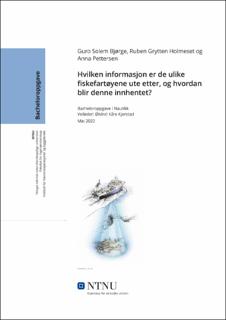| dc.contributor.advisor | Kjerstad, Øivind Kåre | |
| dc.contributor.author | Bjørge, Guro Solem | |
| dc.contributor.author | Holmeset, Ruben Grytten | |
| dc.contributor.author | Pettersen, Anna | |
| dc.date.accessioned | 2022-07-19T17:22:35Z | |
| dc.date.available | 2022-07-19T17:22:35Z | |
| dc.date.issued | 2022 | |
| dc.identifier | no.ntnu:inspera:114859670:114861186 | |
| dc.identifier.uri | https://hdl.handle.net/11250/3007035 | |
| dc.description.abstract | Denne bacheloroppgaven omhandler hvordan line-, trål- og ringnotfartøy anvender hydroakustikk og kartmaskiner for å optimalisere fangst. Hensikten med arbeidet er å avdekke forskjeller i utstyrsbruken på tvers av de tre ovenfornevnte flåtegruppene, samt undersøke om det er betydelige forskjeller på instrumenthåndteringen internt i hver enkelt flåte. Med henblikk på å belyse problemstillingen, har det blitt foretatt litteratursøk og intervju med styrmenn/ skippere om bord et utvalg av norske havgående line-, trål- og ringnotfartøy. For å sette resultatene i kontekst presenterer oppgaven de relevante fiskeslagene, fangstmetodene, samt de tekniske hjelpemidlene; hydroakustikk og kartmaskiner. Intervju som datainnsamlingsmetode blir også presentert og drøftet.
Resultatene viser både likheter og ulikheter. Samtlige av de tre flåtene benytter seg av alle tilgjengelige instrumenter for å sikre best mulig situasjonsforståelse og beslutningsgrunnlag, men det skiller seg noe i bruken av ekkolodd versus sonar. Det fremgår videre at informasjonsinnhentingen innad i hver enkelt flåte er relativt lik mellom fartøyene. Intervjuene avdekket også tydelige personlige preferanser hos intervjuobjektene med tanke på leverandører av instrumenter og kartmaskiner. Resultatene er sannsynligvis representative for den norske fiskeflåten. Dette kan dog ikke garanteres, ettersom resultatene baserer seg på et utvalg av fartøy. | |
| dc.description.abstract | This bachelor’s thesis aims to identify how longline, trawl and purse seine fishing vessels utilise hydroacoustics and chart plotters in order to optimize catch. The purpose of this study is to uncover differences in the utilization of the instruments, both across and within, the mentioned fishing fleets. The research is based upon factual articles and interviews with first mates and captains, onboard a selection of Norwegian, seagoing longliners, trawlers and purse seine vessels. With regard to organization of the results, the thesis presents relevant theory concerning fish species, catching methods, and the technical instruments; hydroacoustics and chart plotters. The implementation of interviews as a research method is also presented and discussed.
The results show both similarities and differences. All three fleets make use of all the available instruments, in order to secure situational awareness and improve decision making. However, the fleets differ in the employment of echosounders versus sonars. Furthermore, the results show that the gathering of information is relatively similar within the individual fleets. The interviews revealed clear personal preferences among the participants, concerning suppliers of the different instruments and systems. These results likely represent the current status within the Norwegian, seagoing fishing fleet. Even so, this can not be guaranteed, as the results are based upon a selection of vessels. | |
| dc.language | nob | |
| dc.publisher | NTNU | |
| dc.title | Hvilken informasjon er de ulike fiskefartøyene ute etter, og hvordan blir denne innhentet? | |
| dc.type | Bachelor thesis | |
